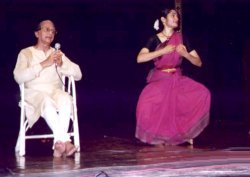
|
 |

|
 |
RHYTHM AS A SIGNIFIER by C V Chandrasekhar and Manjari Rajender Kumar Natya Kala Conference 2001 - December 18 e-mail: chandjay@hotmail.com |
Dec
2002
 Rhythm, what does it mean to us. We know that every living thing has a rhythm cycle of its own. It is there all around us. Starting from the breath, the heart beat and in simple acts like the moving train and threshing and pounding of rice have a rhythmic cycle. Thus we are surrounded by it, we live it, we breathe it. Tagore very beautifully says: 'who is this dancing in my heart all the time and what is this drum playing along?'. He talks of the song and dance of life. From the dance of life we move on to the dance form, which we have tried to make our own. What does rhythm mean to us as dancers. Is it only a beat to which abstract dance is done or does it signify something? We believe that it is a lot more than just a beat. It has a much wider range and scope. Then does it mean a particular meter (chhanda)? Yes it does. Kazi Nazrul Islam says Nataraja dances in ecstasy to the chhanda of creation. So it is not just the meter but has a wider connotation as it helps generate ecstasy; a mood. Therefore rhythm can and does signify a mood / idea depending on how it is used. It is the emotive use and potential of rhythm that we wish to stress on. There are usually two ways of arriving at this: i) Instinctive reaction or reacting by your gut feeling to a rhythmic piece and ii) Consciously setting a rhythmic piece to generate a mood or express an idea with the tools and training one has. We have the concept of Masrina nrittam in the Natya Sastra. The way the rhythm is used i.e. the speed (tempo), the particular division of a rhythmic cycle embellishes the basic mood (the sthayi). Each rhythm has its own inherent mood for which it is best suited, e.g. the khandam is most suited for veera, raudra rasas and the tandava aspect. Similarly the mishram evokes sringara and bhakti. At the same time, the same khandam and misram can completely change in their hues if the stress given on a particular beat changes. e.g. 8 = 4+4 and m 8 = 3+3+2 The second one is definitely more playful. It is like the concept of 'usi'. The same piece can transform if set to usi. The jathi or bol, which are usually termed shushkaksharas in the Natya Sastra, can be used to express an idea. Then there is this whole area of cross rhythms, which are very interesting and wonderful to play with but would require an entire session of its own. Thus the point we wish to stress on is that numerical abstraction and bhava are not polar concepts. They can and do coexist. |
 C.V. Chandrasekhar is an alumnus of the renowned Kalakshetra Dance Academy and is the recipient of the Sangeet Natak Akademi Award for Bharatanatyam, India's highest honour in dance. His troupe Nrityashree has represented India in international festivals in Japan, Hong Kong, Russia and the United States. Chandrasekhar's academic career includes having directed the Dance Departments of the Universities of Vadodara and Varanasi. |
 Manjari has been performing for two decades in major festivals in India and abroad. Her works have been well appreciated for their quality and content. Some of her major works are Yashodhara, Ushas, Ahalya,Rati - A journey, Chandrodayam and Pari - the unflinching giver from the pura nanooru. |